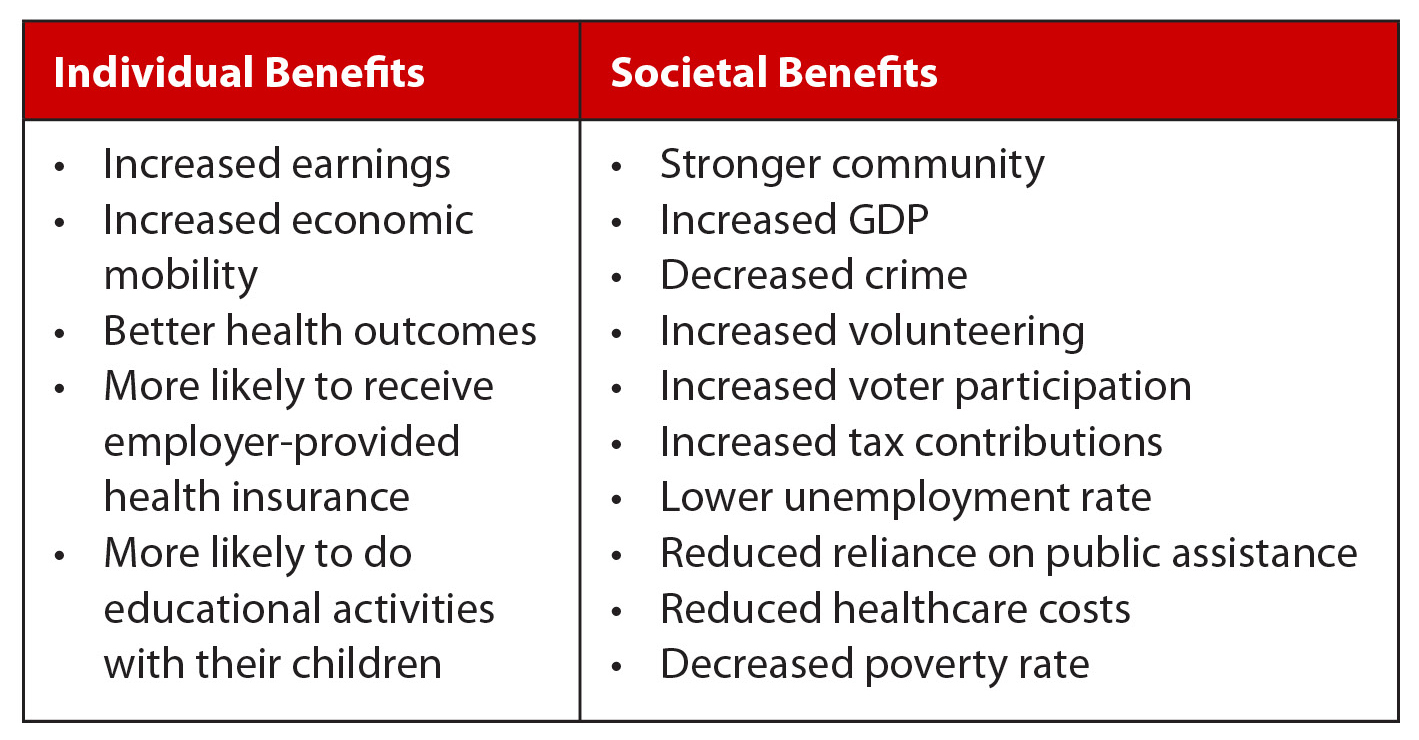Blog Post
Insight: Congrats to the Grads: The Benefits of Higher Education
By: Andrea Thomas Brandley
May 16, 2022 – Over the past few weeks, thousands of Utah families have been celebrating college graduates, my family included. The class of 2022 includes six of my family members (two siblings, three siblings-in-law, and my husband), graduating with various degrees from four different Utah institutions. No matter how many graduation ceremonies I attend, I always end up with tears in my eyes, in awe of the accomplishments and hard work of so many reaching this important milestone. However, graduating college does much more than bring proud tears to family members’ eyes. Increasing educational attainment is associated with many benefits both for the graduate and for society at large.
Some of these many benefits include:
- Reduced unemployment and poverty rates – Those without a high school diploma face an unemployment rate twice as high as those with a bachelor’s degree or higher (3.7% and 1.5% respectively).[i] Additionally, those without a high school diploma have poverty rates four times higher than those with a bachelor’s degree or higher (16.0% and 3.9% respectively).[ii]
- Increased wages, GDP, and tax revenues – Income rises with increases in education. For example, in 2019, Utahns with a graduate or professional degree had a median income of $76,099 compared to a median income of $28,028 for those with less than a high school diploma.[iii] Higher wages can improve quality of life for the individual and indirectly improve society through increases in tax collections and GDP growth.[iv],[v]
- Increased economic mobility and reduced reliance on public assistance – Students coming from an economically disadvantaged background generally have worse outcomes both educationally and economically. However, obtaining education can help reduce these disparities. One national study showed that 74% of those with a college degree earned more than their parents compared to 63% of those without a college degree.[vi] As individuals receive more education, they are also much less likely to rely on public assistance programs including Medicaid, school lunch assistance, Supplemental Nutrition Assistance Program (SNAP), and housing assistance.[vii]
- Better health outcomes – While economic benefits abound, more education is also associated with better health outcomes. These include being less likely to report fair/poor general health, lower obesity rates, lower uninsured rates, being more likely to exercise, and less likely to smoke.[viii]
- Increased volunteerism and civic engagement – While those with more education receive many personal benefits, they are also more likely to give back to their community. Rates of volunteerism rise steadily with increasing levels of education.[ix] Educational attainment is also associated with greater voter participation. Eighty-three percent of those with an advanced degree participated in the November 2020 election, more than 40 percentage points higher than those with less than a high school diploma.[x]
- Improved outcomes for children – Education not only improves outcomes for the recipient but can also positively impact their children. Parents with higher educational attainment are more likely to enroll their children in preschool programs and engage them in a wide variety of educational activities, potentially improving outcomes for generations beyond the original recipient.[xi],[xii]
Benefits of Education
Source: Kem C. Gardner Policy Institute based on literature review
So, congratulations to the college graduating class of 2022! I have cried proud tears on your behalf at four graduation celebrations this year. Enjoy the lifelong benefits of your hard work and thank you for contributing to an improved quality of life for us all.
See the Gardner Institute’s USHE Data Book, released in November 2021, for more details on the costs and benefits of higher education in Utah.
Andrea Thomas Brandley is a research associate at the Kem C. Gardner Policy Institute and a former teacher in Utah’s K-12 public schools.
Note: The opinions expressed are those of the author alone and do not reflect an institutional position of the Gardner Institute. We hope the opinions shared contribute to the marketplace of ideas and help people as they formulate their own INFORMED DECISIONS™.
[i] U.S. Census Bureau American Community Survey 2019 1-year estimates for Utah
[ii] ibid
[iii] ibid
[iv] Scott, S. (2020, September 21). Increased Spending from Postsecondary Graduates in Utah (2011–2018). Utah Data Research Center. https://udrc.utah.gov/increased_spending/report.pdf
[v] Education Pays 2019. CollegeBoard. https://research.collegeboard.org/pdf/education-pays-2019-full-report.pdf
[vi] Haskins, R. (2016). Education and Economic Mobility. Brookings Institute.
https://www.brookings.edu/wp-content/uploads/2016/07/02_economic_mobility_sawhill_ch8.pdf
[vii] Education Pays 2019. CollegeBoard. https://research.collegeboard.org/
pdf/education-pays-2019-full-report.pdf
[viii] Behavioral Risk Factor Surveillance System, Office of Public Health Assessment, Center for Health Data and Informatics, Utah Department of Health. Retrieved 12 July 2021 from the Utah Department of Health, Indicator-Based Information System for Public Health web site: http://ibis.health.utah.gov
[ix] Bureau of Labor Statistics
[x] U.S. Census Bureau, Voting and Registration in the Election of November 2020, Table 5
[xi] National Center for Education Statistics, Table 202.20
[xii] Education Pays 2019. CollegeBoard. https://research.collegeboard.org/pdf/education-pays-2019-full-report.pdf







